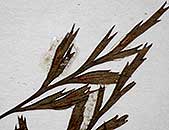Asplenium linckii Kuhn
Synonyms |
Asplenium daubenberghii Rosenst. |
|---|---|
Common name |
|
Description |
Rhizome shortly creeping to suberect, up to 5 mm diameter; rhizome scales up to 6 x 0.3-1 mm, shiny brown, lanceolate to narrowly triangular in outline, entire, apex gradually tapering to a point and ending in a hair-tip. Fronds tufted or shortly spaced, not proliferous, arching, firmly herbaceous. Stipe 9-40 cm, matt brown to black, subglabrous above, base with scales similar to rhizome. Lamina (8-)11-33(-60) × (3-)10-27 cm, 3-pinnate to 5-pinnatifid, ovate-triangular in outline, finely dissected, basal pinnae the largest, apex decrescent. Pinnae 15-20 pairs, broadly ovate-triangular in outline, up to 17 x 10 cm. Ultimate segments wedge-shaped or narrowly obcuneate, up to 8-10 x 2-4 mm, apex with doubly toothed-truncate margins with teeth to 2 mm long, hairless on both surfaces or sometimes with a few minute scales beneath. Sori 1-3 per ultimate segment, elliptic in outline, 1.5-6 mm long; indusium entire, linear, membranous, 0.3-0.4 mm wide. |
Notes | Differs from similar species by sharply serrated apical margins and small pinnules. |
Derivation | linckii: named after H.A. Linck, German physician and collector on the von der Decken expedition. |
Habitat | Deep shade in evergreen forest. |
Distribution worldwide | See African distribution. |
Distribution in Africa |
Burundi, Dem. Republic of Congo, Ethiopia, Kenya, Malawi, Rwanda, Tanzania , Uganda, Zimbabwe. |
Growth form |
Epiphytic, lithophytic, terrestrial. |
Literature |
|



